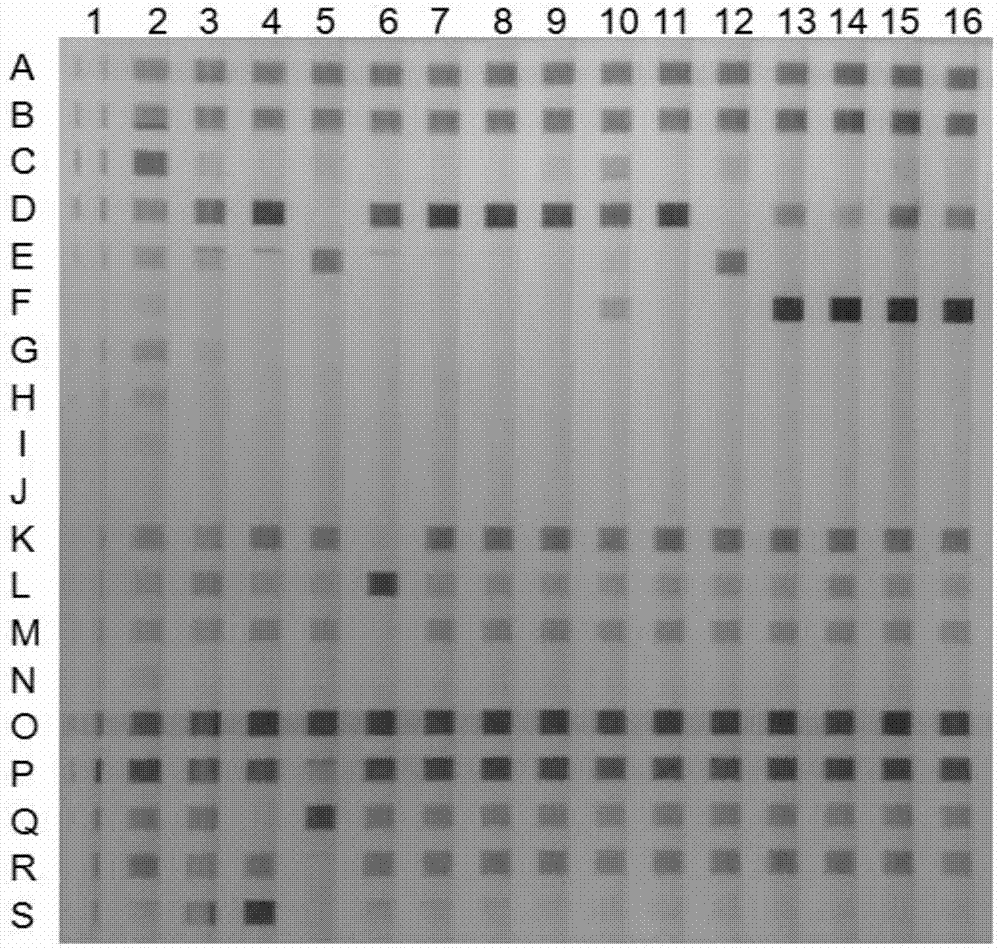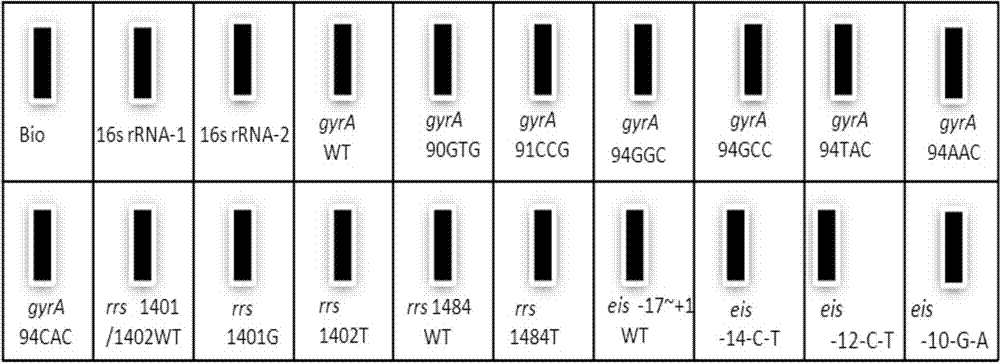Specific fragment composition of mycobacterium tuberculosis drug-resistant gene of four second-line drugs and application thereof
A technology of Mycobacterium tuberculosis and nucleic acid fragments, applied in the field of drug resistance detection of Mycobacterium tuberculosis
- Summary
- Abstract
- Description
- Claims
- Application Information
AI Technical Summary
Problems solved by technology
Method used
Image
Examples
Embodiment 1
[0172] Example 1. Preparation of fluoroquinolones, kanamycin, amikacin and capreomycin sensitivity detection film strips
[0173] 1) Use Clone Manager (Professional Suite) to target the mutation site of the fluoroquinolone resistance-related gene gyrA, kanamycin, amikacin, and capreomycin resistance-related gene rrs, and the mutation site of the eis promoter Point design probe sequence, the probe sequence is SEQ ID NO:8-24;
[0174] 2) Using Clone Manager (Professional Suite) to design the Mycobacterium tuberculosis complex species-specific 16S rRNA probe sequence, the probe sequence is SEQ ID NO.6-7;
[0175] 3) According to the prior art, synthesize sequences such as each probe shown in SEQ ID NO.6-24, and make an amino label at the 5' end of the probe;
[0176] 4) Design and synthesize a biotin sequence probe (SEQ ID NO.5), labeling with amino group at the 5' end and biotin labeling at the 3' end;
[0177] 5) Dilute the newly synthesized probe with TE buffer to make the f...
Embodiment 2
[0188] Example 2. Detection of fluoroquinolone, kanamycin, amikacin and capreomycin resistance of Mycobacterium tuberculosis
[0189] In this example, performance tests were performed on the prepared fluoroquinolone, kanamycin, amikacin and capreomycin sensitivity detection membrane strips.
[0190] Acquisition and identification of resistant strains
[0191] 14 strains of Mycobacterium tuberculosis were obtained from sputum specimens of 14 tuberculosis patients from Fujian, Tibet and Gansu provincial tuberculosis control institutions, among which 11 strains were resistant to quinolones, 3 strains were resistant to both quinolones and kanamycin, The resistant phenotype was determined by the assay described below.
[0192] The drug susceptibility test was carried out by traditional Roche medium ratio method. Take 1 ring of Mycobacterium tuberculosis grown on Roche's medium for 4-5 weeks, grind the bacteria to make 1 McFarland turbidity, and then adjust it to 10 with normal ...
Embodiment 3
[0223] Example 3. Detection of fluoroquinolones, kanamycin, amikacin and capreomycin resistance of Mycobacterium tuberculosis and comparison with other testing methods
[0224] The present embodiment tested the effect of the fluoroquinolones prepared according to the application, kanamycin, amikacin and capreomycin sensitivity detection membrane strips on a larger scale, and compared with the conventional solid medium ratio method ( Phenotype detection) and the results obtained by DNA sequencing method for cross-comparison.
[0225] Examples 1 and 2 show the preparation method and detection method of film strips for detecting drug susceptibility to fluoroquinolones, kanamycin, amikacin and capreomycin.
[0226] Using the fluoroquinolones, kanamycin, amikacin and capreomycin sensitivity test strips prepared by this application to analyze the gyrA gene mutation of 214 clinical isolates of Mycobacterium tuberculosis, the results showed that 59 strains of fluoroquinolones Mutatio...
PUM
| Property | Measurement | Unit |
|---|---|---|
| Sensitivity | aaaaa | aaaaa |
Abstract
Description
Claims
Application Information
 Login to View More
Login to View More - R&D
- Intellectual Property
- Life Sciences
- Materials
- Tech Scout
- Unparalleled Data Quality
- Higher Quality Content
- 60% Fewer Hallucinations
Browse by: Latest US Patents, China's latest patents, Technical Efficacy Thesaurus, Application Domain, Technology Topic, Popular Technical Reports.
© 2025 PatSnap. All rights reserved.Legal|Privacy policy|Modern Slavery Act Transparency Statement|Sitemap|About US| Contact US: help@patsnap.com



